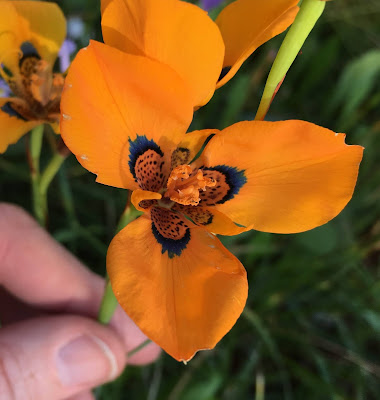To me, these are stunning flowers: brilliant orange and brilliant blue, with black freckles thrown in.
In captivity, the forms you usually see have a large or narrow blue eye, which is sometimes colored slate or black, or is absent altogether. Judging from online photographs and correspondence I've exchanged with folks in South Africa, there's a lot more variability in nature.
Botanists have merged Moraea neopavonia with a related species, Moraea tulbaghensis. Intermediate forms between the two species were found in the wild, and it became very difficult to tell them apart. I use the old name to identify my plants that have the forms shown here.
Big blue eye:
Narrow blue eye:
Gray-blue eye:
Black eye:
Some other variants:
Deeper orange color, big blue eye. I call this form 'Summerfield' in honor of Gordon Summerfield, the South African bulb grower who supplied it to me:
Eye almost missing:
Almost no eye, streaky tepals. I informally called this striking flower 'Sunrise.' Unfortunately, it died away after a few years, but it was a good pollen parent, and many of its offspring inherited its intense orange center. The bulb veterans always tell you, if you like a particular plant, propagate it. I've learned that lesson, to my regret, several times.
An intermediate form between M. neopavonia and M. tulbaghensis. Eye is bluish and flowers are fairly flat, but they're the smaller size typical of M. tulbaghensis, and are somewhat cupped. I think it's because of flowers like this that the two species were merged.












No comments:
Post a Comment
Due to spam, I am now requiring moderation for comments on most posts. I apologize if your comment does not appear immediately; I will approve it as soon as I can.